#darpa robotics challenge
Explore tagged Tumblr posts
Text
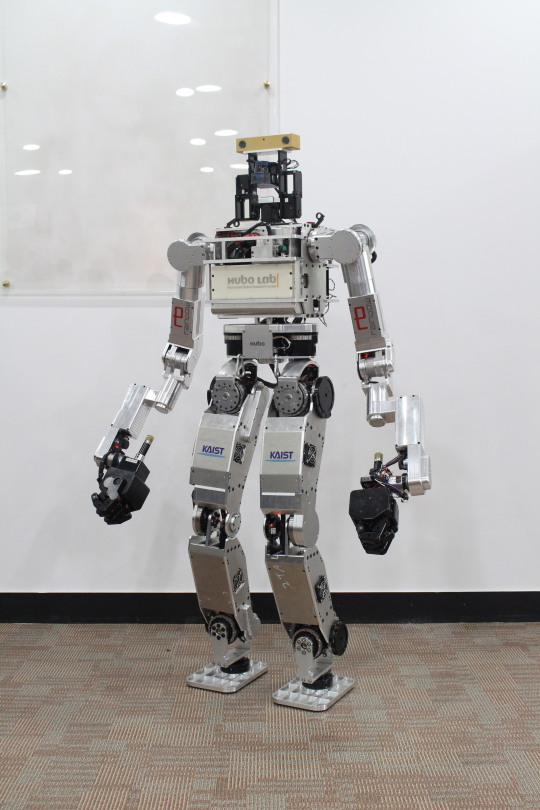
DRC-HUBO by KAIST (2013)
#robotics#robots#humanoid robots#bipedal robots#dual arm manipulators#2010s#2010s robots#2013#robots from 2013#south korea#south korean robots#korea#korean robots#kaist#korea advanced institute of science and technology#darpa#darpa robotics challenge
3 notes
·
View notes
Text

youtube
#art#ieee spectrum#darpa robotics challenge#robot#was linked this video and had to draw the robotaur thing#Youtube
1 note
·
View note
Text

What does an ancient lava tube in the Canary Islands have in common with space exploration?
For our robotics teams, it turns out, quite a lot.
A small group of our researchers traveled to Lanzarote, more than 18,000 km from their home base in Brisbane, to test their navigation and mapping technology with the German Aerospace Center (DLR) in a lava tube—a tunnel through rock, deep underground.
Their purpose? Understand how DLR's SCOUT Rover would perform in lava tubes much, much further away—beneath the surface of the moon and Mars.
What is a lava tube?
Lava tubes are natural tunnels created by lava flowing along or under the surface. The outer layer of the lava flow cools, forming a crust. As the hotter lava drains away, it leaves behind a tunnel. These tunnels can be up to 65 km long and tens of meters wide. The pitch dark, uneven surface and large rocky obstacles pose significant challenges to robotic and human explorers alike.
The Lanzarote lava tube system is an accessible testing ground for DLR's SCOUT Rover, tailor-made for navigating the complex terrain. Instead of using traditional wheels, the rover deploys novel spoked wheels and flexible back elements to navigate through and around obstacles.
Of course, Earth isn't the only planet in our solar system with lava tubes.
Natural protection from cosmic radiation
Space is dangerous. Without Earth's protective magnetic field, solar and cosmic radiation pose life-threatening danger to human space explorers.
But it turns out you don't need a magnetic field to shield astronauts and equipment from the worst space has to offer—you just need rocks and dirt.
Ross Dungavell is a Senior Engineer in our robotics team. He said lava tubes provide ideal shelter from the intense conditions of space.
"On the lunar surface, you get 13.8 days of sunlight, then 13.8 days of night—with temperatures ranging from 130°C to -180°C. In comparison, lava tubes are a constant, mild temperature," he said.
Along with protection from radiation and harsh temperatures, the lava tubes would protect astronauts from micrometeorite impacts.
"They date back to the moon's volcanic activity, so if they exist today, they've been stable for one to many billions of years," Ross said.
"You get to have a look at this very old, very untouched lunar geology [that is] by lunar standards, an extremely pleasant environment."
Fred Pauling, a Principal Engineer in our robotics team, added that lava tubes offer an array of exciting scientific opportunities.
"It's potentially a pristine way to inspect the subsurface geology without having to drill. [On Mars] these lava tubes could be places that continue to have life, or signs of life," he said.
Award-winning autonomous navigation
If you're looking to explore underneath rocks and dirt, CSIRO is a good place to start.
"Lava tubes really represent, from a technical perspective, an extension of the work we've done in other subterranean environments, like underground mine sites and caves," Fred said.
That work includes Wildcat SLAM—a mapping technology that's also been deployed on the International Space Station—and Navstack, which uses that information to plot a robot's course in 3D space.
The technology was deployed at the DARPA Subterranean Challenge, where 11 teams used their tech to autonomously navigate a cave. The team's work attracted the attention of DLR, paving the way for collaboration on extraterrestrial lava tubes.
Dr. Roy Lichtenheldt is the project manager of the DLR SCOUT Rover.
"Caves have many obstacles. If you move around, you can see a lot of breakdowns, big piles of rubble, sometimes even hard to get over as a human," he explained.
"While we are responsible for the locomotion system, CSIRO supplies perception and autonomy with the LIDAR. Our collaboration helps us to let the rover navigate through the cave without human intervention, which is especially important for us."
"On the moon and Mars, we have a signal delay and very short mission duration, so any call back to Earth would cost us precious time. For this reason, the rover has to make decisions on its own and be extremely robust. We want to tune the autonomy, enabling the rover to find its path, while not limiting itself by avoiding too many obstacles."
Our team returned to Australia with plenty of work to do. Fletcher Talbot is a Senior Robotics Research Engineer in the team.
"It was hard in Lanzarote to really pinpoint exactly what was working and what wasn't working," Fletcher said.
"Next steps will be to really delve down into the specifics and understand what components work, what don't work and what needs to be done to make it more performant."
They hope to bring a model SCOUT Rover to Brisbane to further integrate the technologies.
From there, the sky is not the limit. With an international effort, the team hopes that future funding could bring the technology to lava tubes on the moon, and one day Mars.
But for each of them, the experience on Lanzarote is one worth cherishing.
"Everywhere you go, you're completely surrounded by volcanoes and lava flows. You really got a sense of, if you're on the moon, this is the kind of environment you might be faced with," Fred said.
"It's the best part of the job, honestly. Seeing our tech out in the real world doing real things … you have to accept some humility because something quite often doesn't work in the real world," Fletcher said.
"But the best part of any of this development process is to really understand where the technology falls down and where it exceeds expectations."
IMAGE: DLR's SCOUT Rover is designed to explore the complex terrain of lava tubes. Credit: Roy Lichtenheldt, DLR
4 notes
·
View notes
Photo
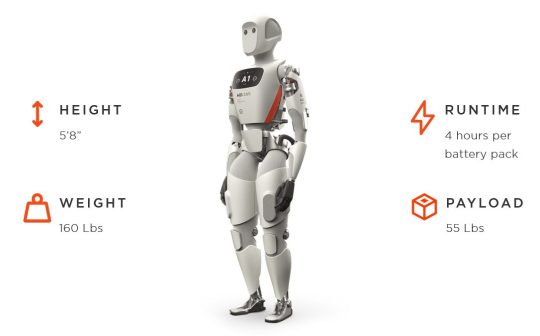
Apptronikといえば、2013年にNASAと共同でヒト型ロボット「Valkyrie」を開発したことで知られている。これは米国防総省が行ったロボット技術開発コンテスト「DARPA Robotics Challenge(DRC)」の一環で製作された物だが、このときの経験もあって、NASAは昨年新世代の汎用ロボット開発に協力する民間パートナー企業としてApptronikを選定している。そしてこのコラボレーションによって生み出された最初のロボットがApolloということになる。 Apolloはだいたい人間と同じサイズで設計されている。その体格は約172cm、約72.6kgといったガッチリ型で、25kgぐらいまでの重量物を持ち上げる力を備えている。よくある1本腕の産業用ロボットではなく、人と共存しやすいよう、ユーモラスな顔を持つデザインとともに、人々のいる場所で安全に機能するための出力制御機構も備えているという。 少し物足りないのはスタミナで、動力源であるバッテリーの連続動作時間は約4時間。朝8時に朝礼を済ませたら、お昼にはもうへばってしまう。そのためか、バッテリーは交換式を採用してすぐに戦線復帰が可能なようになっている。プレスリリースには「バッテリーベースのアプローチが、Apolloの作業アウトプットの向上と顧客ユーザーの運用効率向上をもたらす」と説明されている。 Apptronikは、Apolloを仕事に適応させることができるロボットだと説明しており「人間中心のビジョンを実現し、産業環境で危険で汚れたタスクを実行し、将来的には無限の応用を実行することを目指している」と説明している。ただし、1体あたりの価格がどれぐらいになるのか、発売時期がいつ頃かはリリースには示していない。 同様のヒューマノイドロボットとしては、テスラのヒト型ロボットTesla Bot(開発名:Optimus)や、そのコ��ーロボットのようなXiaomiの「Cyber One」がある。こうしたロボットのなかのどれが、本当に実用に供する形で世の中に出てくるのか、楽しみに待ちたいところだ。
(ヒト型ロボット「Apollo」発表。“工事現場から配送、介護まで”謳うなんでもロボ | Gadget Gateから) 2023/08/24 13:22
3 notes
·
View notes
Text
Robot Multi-fingered Dexterous Hand Market Growth Analysis, Market Dynamics, Key Players and Innovations, Outlook and Forecast 2025-2032
According to a new market analysis, the global Robot Multi-fingered Dexterous Hand market was valued at USD 84.7 million in 2024 and is projected to reach USD 5,613 million by 2032, growing at a Compound Annual Growth Rate (CAGR) of 74.4% during the forecast period (2025–2032). The growth is fueled by advancements in robotics, artificial intelligence, and increasing adoption across medical, industrial, and service sectors.
What are Robot Multi-fingered Dexterous Hands?
Robot multi-fingered dexterous hands are advanced robotic end-effectors designed to mimic human hand functionality. These systems typically feature 3-5 fingers with multiple joints (often 3 per finger) and incorporate force/tactile sensors for adaptive grasping. Unlike traditional industrial grippers limited to single functions, dexterous hands enable polyvalent manipulation across objects of varying shapes and sizes across industries.
Key Market Drivers
1. Surging Demand in Medical Robotics
The medical sector accounts for approximately 34% of current dexterous hand applications, driven by robotic-assisted surgeries. Systems like Intuitive Surgical's da Vinci SP demonstrate sub-millimeter precision, reducing patient recovery times by an average of 27% compared to traditional methods. Recent FDA clearances have accelerated adoption in neurosurgery and microsurgery where human-like dexterity is paramount.
2. Industrial Automation Revolution
Industrial applications represent 41% of market share, with automotive manufacturers adopting dexterous hands for handling diverse components. Modern systems achieve cycle times under 0.8 seconds while maintaining 99.8% grip reliability, translating to 15-20% production efficiency gains in pilot installations. Collaborative robots (cobots) with adaptive grippers are seeing 62% annual deployment growth.
Market Challenges
Despite rapid advancements, high development costs (exceeding $50,000 per unit) and technical complexity restrain widespread adoption. Integration with existing systems typically requires 6+ months of specialized engineering, while maintenance of hundreds of precision components demands regular servicing. The absence of standardized safety protocols for collaborative workspaces creates additional adoption barriers.
Growth Opportunities
The $3 billion logistics sector presents significant potential for adaptable gripping solutions. Emerging applications in elder care robotics and food preparation address critical labor shortages. Strategic partnerships are accelerating commercialization - notably Shadow Robot Company's collaboration with Google DeepMind on the modular DEX-EE hand featuring hundreds of tactile sensors per finger.
Regional Insights
North America leads with 38% market share, driven by DARPA-funded research and strong medical robotics adoption. The U.S. accounts for 89% of regional revenue.
Europe shows strong growth in industrial applications, with Germany's manufacturing sector deploying SCHUNK's SVH 5-finger grippers in 120+ facilities.
Asia-Pacific is the fastest-growing region (82% CAGR) with China's "Made in China 2025" initiative investing $150 million in dexterous robotics R&D.
Middle East & Africa focuses on oil/gas applications, with ADNOC deploying the first dexterous robotic systems for offshore maintenance in 2024.
Competitive Landscape
Shadow Robot Company maintains technology leadership with its 24-DoF Shadow Hand series, holding 19% of the research market.
Tesla (Optimus) and SCHUNK are scaling production, with Tesla's Optimus hand achieving 60% cost reduction through mass production techniques.
The April 2025 partnership between Agility Robotics and Schaeffler AG will deploy 240+ Digit robots with dexterous hands across global factories for logistics automation.
Market Segmentation
By Type:
Built-in Type (62% market share)
External Type
Hybrid Type
By Mobility:
Fixed/Stationary (Primary industrial use)
Mobile/Robot-mounted (Growing 89% YoY)
By Application:
Surgical Assistance (34%)
Precision Assembly (41%)
Logistics Automation ($3B opportunity)
By Region:
North America, Europe, Asia-Pacific, Latin America, Middle East & Africa
Report Scope & Offerings
This comprehensive report provides:
2024-2032 market forecasts with 74.4% CAGR analysis
Competitive intelligence on 16+ players including Shadow Robot, Tesla, SCHUNK
Patent analysis of 120+ dexterous hand technologies
Implementation case studies from automotive, medical, and logistics sectors
Download FREE Sample Report: Robot Multi-fingered Dexterous Hand Market
View Full Report: Detailed Market Analysis (2025-2032)
Visit more reports :
https://sidintelmarketresearch.blogspot.com/2025/06/m-toluidine-market-growth-analysis-2025_18.htmlhttps://sidintelmarketresearch.blogspot.com/2025/06/frac-valves-market-growth-analysis-2025.htmlhttps://sidintelmarketresearch.blogspot.com/2025/06/fertigation-system-market-growth.htmlhttps://sidintelmarketresearch.blogspot.com/2025/06/carbomer-market-growth-analysis-2025.htmlhttps://sidintelmarketresearch.blogspot.com/2025/06/ceramic-dielectric-waveguide-filter.htmlhttps://sidintelmarketresearch.blogspot.com/2025/06/chromatic-confocal-sensors-market.htmlhttps://sidintelmarketresearch.blogspot.com/2025/06/cabin-for-construction-machinery-market.htmlhttps://sidintelmarketresearch.blogspot.com/2025/06/anti-reflective-window-film-market.htmlhttps://sidintelmarketresearch.blogspot.com/2025/06/5g-antennas-market-growth-analysis-2025.html
About Intel Market Research
Intel Market Research delivers actionable insights in technology and infrastructure markets. Our data-driven analysis leverages:
Real-time infrastructure monitoring
Techno-economic feasibility studies
Competitive intelligence across 100+ countries Trusted by Fortune 500 firms, we empower strategic decisions with precision. International: +1(332) 2424 294 | Asia: +91 9169164321
Website: https://www.intelmarketresearch.com
Follow us on LinkedIn: https://www.linkedin.com/company/intel-market-research
0 notes
Text
Neuromorphic Chip Market Emerging Trends Shaping Future Intelligent Computing Systems
The global neuromorphic chip market is rapidly evolving, propelled by increasing demand for energy-efficient, brain-inspired hardware capable of handling complex computational tasks. Neuromorphic chips, modeled after the human brain's neural architecture, offer immense advantages in cognitive processing, enabling real-time learning, low power consumption, and adaptive performance. With industries embracing AI-driven solutions, the demand for neuromorphic chips is expected to surge, fostering innovation across sectors such as robotics, automotive, healthcare, and defense.

Emerging Trends in the Neuromorphic Chip Market
1. Rising Integration of Neuromorphic Chips in Edge AI Devices
One of the most notable trends is the increasing deployment of neuromorphic chips in edge computing environments. Traditional cloud-based AI systems face challenges such as latency, bandwidth limitations, and data privacy concerns. Neuromorphic chips, with their low power consumption and real-time processing abilities, are ideal for edge AI applications like smart cameras, drones, autonomous vehicles, and IoT devices. Their capability to perform on-device learning and decision-making is transforming edge AI, enhancing speed, efficiency, and data security.
2. Growing Adoption in Autonomous Vehicles and Robotics
The autonomous vehicle industry and robotics sector are among the early adopters of neuromorphic technology. Self-driving cars and intelligent robots require systems that can process massive amounts of sensory data, adapt to dynamic environments, and make real-time decisions. Neuromorphic chips replicate the brain’s neural networks, making them exceptionally suitable for such applications. Companies are investing heavily in integrating neuromorphic processors to improve perception, navigation, and decision-making capabilities, contributing to safer and more efficient autonomous systems.
3. Expansion of Neuromorphic Computing in Healthcare Devices
Healthcare is emerging as a significant application area for neuromorphic chips. Medical devices equipped with neuromorphic processors are being developed for real-time monitoring, predictive diagnostics, and intelligent prosthetics. These chips enable continuous learning and adaptation, essential for devices assisting patients with neurological disorders, wearable health monitors, or AI-based diagnostic systems. The fusion of neuromorphic technology with healthcare is expected to enhance patient care, improve diagnostic accuracy, and enable more personalized medical interventions.
4. Advancements in Brain-Machine Interfaces (BMI)
The convergence of neuromorphic chips with brain-machine interfaces is accelerating research into advanced neuroprosthetics and human augmentation technologies. Neuromorphic hardware can process neural signals more efficiently and in real time, facilitating better communication between human brains and machines. This trend is particularly promising for assisting individuals with motor disabilities, developing mind-controlled devices, and exploring cognitive enhancement technologies.
5. Increasing Research and Collaboration Initiatives
Global research institutions, tech companies, and governments are investing significantly in neuromorphic computing research. Collaborative projects such as the Human Brain Project and DARPA's SyNAPSE program are driving innovation in neuromorphic chip design, materials, and architectures. This surge in collaborative efforts aims to overcome existing technological barriers, enhance scalability, and develop next-generation neuromorphic processors suited for commercial deployment.
6. Emergence of Neuromorphic Hardware Startups
The neuromorphic chip market is witnessing a wave of startups focused on specialized neuromorphic hardware solutions. These startups are introducing innovative chip designs leveraging novel materials like memristors, spintronics, and phase-change memory to emulate synaptic behaviors. Their agile approach to R&D and niche focus areas are accelerating breakthroughs in chip performance, energy efficiency, and scalability, challenging traditional semiconductor players to innovate faster.
7. Energy-Efficient Computing Driving Market Demand
With growing concerns over the energy consumption of AI data centers and computing infrastructures, energy-efficient neuromorphic chips are gaining traction. These chips offer significant reductions in power usage compared to conventional processors while maintaining high-performance cognitive processing capabilities. As sustainability becomes a critical focus for technology development, neuromorphic chips are poised to play a vital role in achieving greener, low-power AI systems.
Conclusion
The neuromorphic chip market is at the forefront of redefining intelligent computing with its brain-inspired design and unparalleled efficiency. Emerging trends such as edge AI integration, healthcare applications, autonomous systems, and advancements in BMI are fueling market expansion. As research, collaborations, and startup innovations continue to accelerate, neuromorphic chips are expected to become a cornerstone of next-generation AI, fostering breakthroughs across industries and revolutionizing how machines learn and interact with the world.
0 notes
Text
The new Atlas robot looks amazing!
1 note
·
View note
Text

Amazing Rescue Robotics Alliance: CMU and Pitt Tackle DARPA Challenge! CMU and Pitt have formed Team Chiron to compete in the DARPA Triage Challenge, showcasing cutting-edge rescue robotics for disaster response and revolutionizing emergency care.
Read more
0 notes
Quote
I think we're going to need to be patient. I think there's a lot of like -- it's a hype cycle. We've all seen it before. Like this thing is the greatest thing ever. It's coming next year. I remember I was in the -- I was part of the Stanford AI lab when we built a self-driving car that won The Darpa Grand Challenge in 2005. This is like a car that can drive itself across Death Valley. Like 100 miles automated car. Sebastian Thrun was leading the robotics team. This is [05] (ph) and everybody is like self-driving cars are here. They're coming. It's going to be 3 to 5 years. Everybody is like it's 3 to 5 years, and it's like everything is 3 to 5 years away. And I think we just like people need to be patient with technology and like have some amount of this passion that like some things are going to happen really fast and some things that seem easier and to take a long time because edge cases are crazy hard, especially when you're dealing with something like a car driving itself. But even when we talk about intelligence, there are so many pieces of what we are saying that are very subtle that are very deeply human and are not just about sort of like doing really well in math. And I think that surface area around intelligence is going to be the stuff that takes a lot longer. And that's where I think the patience is going to be important.
Meta Platforms, Inc. (META) Morgan Stanley 2025 Technology, Media & Telecom Conference (Transcript)
The GenAI cycle is in early days, and patience is needed to fully realize its potential #Tech
0 notes
Text
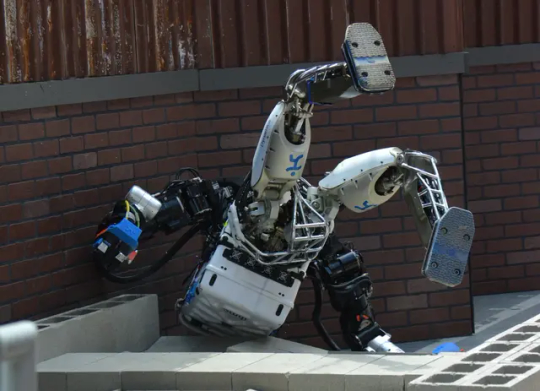
Atlas by Boston Dynamics (2013)
#robotics#robots#humanoid robots#bipedal robots#dual arm manipulators#2010s#2010s robots#2013#robots from 2013#united states#american robots#boston dynamics#team ihmc#darpa#darpa robotics challenge
3 notes
·
View notes
Link
Satellites often face a disappointing end: despite having fully working systems, they are often de-orbited after their propellant runs out. However, a breakthrough is on the cards with the launch of China’s Shijian-25 satellite which has been launched into orbit to test orbital refuelling operations. The plan; docking with satellite Beidou-3 G7 and transferring 142 kilograms of hydrazine to extend its life by 8 years! It’s success will mean China plans to develop a network of orbital refuelling stations! Like cars on Earth, satellites need fuel to manoeuvre and for their constantly decaying orbits to be boosted. But unlike vehicles on the ground, when satellites run out of propellant, they become expensive space debris. This challenge has driven the development of orbital refuelling technology, which could extend satellite lifespans and transform space operations. An artist’s conception of ERS-2 in orbit. ESA The International Space Station (ISS) offers one of the most well known examples of an orbiting ‘satellite’ and it too needs to deal with boosting its orbit. The problem is the drag imposed upon the structures by gas in our atmosphere. In the case of the ISS, docked supply craft are typically used to fire their engines to reposition ISS to the correct altitude. Without these periodic “orbital boosts,” the ISS would eventually lose altitude and reenter the atmosphere. The International Space Station (ISS) in orbit. Credit: NASA A significant milestone in autonomous refuelling came in 2007 with DARPA’s Orbital Express mission. This demonstration involved two spacecraft: the ASTRO servicing vehicle and a prototype modular satellite called NextSat. Over three months, they performed multiple autonomous fuel transfers and component replacements, proving that robotic spacecraft could conduct complex servicing operations without direct human control. The technology continues to advance with China’s Shijian-25 satellite (launched on 6 January 2025) representing another step forward in orbital refuelling capabilities. The mission aims to demonstrate refuelling operations in geosynchronous orbit approximately 36,000 kilometres above Earth. This is particularly significant because geosynchronous orbits often host communications satellites that benefit from life extension. The technical challenges of orbital refuelling are considerable though. Spacecraft must achieve extremely precise rendezvous and docking while travelling in excess of 28,000 kilometres per hour. The fuel transfer system must prevent leaks, which could be hazardous to both spacecraft and create hazardous debris. Adding to the challenge is that many satellites were never designed with refuelling in mind, lacking any form of standardised fuel ports or docking interfaces. Orange balls of light fly across the sky as debris from a SpaceX rocket launched in Texas is spotted over Turks and Caicos Islands on Jan. 16, in this screen grab obtained from social media video. Credit: Marcus Haworth/Reuters Looking ahead, several companies and space agencies are developing orbital refuelling systems. These range from dedicated “gas station” satellites to more versatile servicing vehicles that can perform repairs and upgrades alongside refuelling. As the technology advances, it could significantly change how we operate in space, making satellite operations more sustainable and cost-effective. Source : China successfully sent Shijian-25 satellite The post A Chinese Satellite Tests Orbital Refuelling appeared first on Universe Today.
0 notes
Video
youtube
"DARPA Robotics Challenge: Revolutionizing Disaster Response with Advanc...
0 notes
Text
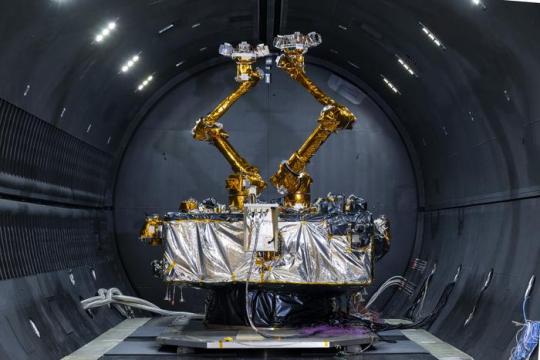
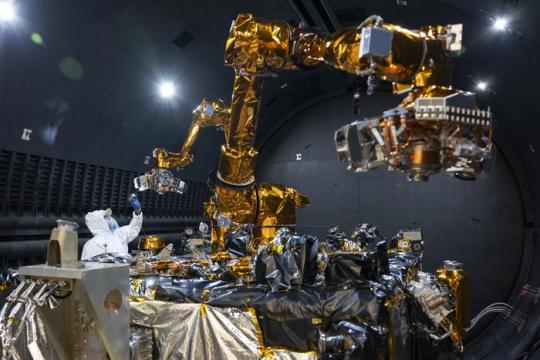

NRL completes development of robotics capable of servicing satellites, enabling resilience for the U.S. space infrastructure
U.S. Naval Research Laboratory (NRL) Naval Center for Space Technology (NCST) in partnership with Defense Advanced Research Projects Agency (DARPA) successfully completed development of a spaceflight qualified robotics suite capable of servicing satellites in orbit, Oct. 8.
Under DARPA funding, NRL developed the Robotic Servicing of Geosynchronous Satellites (RSGS) Integrated Robotic Payload (IRP). This transformative new space capability was delivered to DARPA’s commercial partner, Northrop Grumman’s SpaceLogistics, for integration with its spacecraft bus, the Mission Robotics Vehicle (MRV).
“The recent completion of thermal vacuum testing marks a major milestone toward achieving the program’s goal of demonstrating robotic servicing capabilities on orbit in the near future,” said NRL Director of Research Dr. Bruce Danly. “NRL’s contributions to the robotic payload are an essential part of realizing this vision, which promises to transform satellite operations in geostationary orbit, reduce costs for satellite operators, and enable capabilities well beyond what we have today. In fact, the anticipated capabilities are potentially revolutionary for both national security and civil applications.”
As DARPA’s robotic payload developer for the RSGS program, NRL looked to the future to design, build, integrate, and test groundbreaking satellite servicing capabilities.
“This collaboration unlocks new servicing opportunities for both commercial and government satellites, enabling usual-close inspections, orbital adjustments, hardware upgrades, and repairs,” said Bernie Kelm, NRL NCST superintendent of the Spacecraft Engineering Division. “We’ve created advanced spaceflight hardware and software that will significantly enhance satellite servicing operations, including all robotic controls.”
Satellites in geosynchronous orbit, positioned approximately 22,000 miles above Earth, are crucial for military, government, and commercial communications, Earth-observing science, and national security services.
Currently, spacecraft face significant challenges, in part because of the inability to perform in-orbit repairs or upgrades. To compensate for the lack of servicing options, satellites are often loaded with backup systems and excess fuel, leading to increased complexity, weight, and cost. Should this project prove successful, satellites can receive in-orbit upgrades based on new technology to extend their service life, Kelm added.
“The military regularly fixes aircraft, tanks, ships, and trucks that break. We upgrade aircraft and ships with the latest radars, computers, and engines,” said Glen Henshaw, Ph.D., NRL senior scientist for Robotics and Autonomous Systems. “Satellites are the only expensive equipment we buy that can’t be repaired or upgraded once they are in the field, and this costs the taxpayer money. RSGS is intended to change this situation; we intend to demonstrate that we can upgrade and repair these valuable assets using robots.”
Thermal Vacuum (TVAC) Testing Process The test campaign put the robotic payload through its paces across the range of temperatures it will face while on-orbit and under vacuum conditions similar to space. Engineers tested all aspects of the payload including avionics, cameras, and lights, and demonstrated all operations, with each of its two robotic arms including launch lock deployments, calibrations, and tool changing. The test also verified SpaceWire communications and robotic compliance and visual servo control modes.
“NRL’s Team RSGS has spent nearly 10 years focused on the goal of completing this first of a kind, robotic servicing payload,” said William Vincent, NRL RSGS program manager. “The completion of IRP TVAC represents a huge milestone and countless hours of work from an incredible group of dedicated personnel. Like sending a child off to college for the first time, shipping the IRP to Dulles is a bittersweet experience.”
NRL worked for over two decades to mature the technology enabling the RSGS program. RSGS is designed to safely and reliably repair and upgrade valuable commercial, civil, and national security satellites, some of which cost over a billion dollars. In the near future, robotic satellite “mechanics” may extend the useful life of satellites by upgrading a variety of capabilities including new electronics, propulsion, and sensors capabilities. RSGS robots could demonstrate broad servicing as a precursor to building large structures in-orbit which could include the next great observatory, solar power stations, or other revolutionary new systems.
“We hope that this will eventually lead to spacecraft that are more modular and easier to maintain,” Henshaw said.
Following its anticipated 2026 launch on the Northrop Grumman’s MRV spacecraft bus, the robotic payload will undergo initial checkout and calibration with full operational servicing missions to follow.
“We will proudly watch RSGS as it provides resilience for the current U.S. space infrastructure and takes the first concrete steps toward a transformed space architecture with revolutionary capabilities,” Vincent said.
About the U.S. Naval Research Laboratory
NRL has a longstanding relationship with academia and industry as a collaborator, contractor, and through technology transfer partnership mechanisms, such as commercial licensing, Cooperative Research and Development Agreements, and Educational Partnership Agreements.
NRL is a critical link within the Navy’s Research, Development, and Acquisition chain and Naval Research Enterprise. Through NRL, the Navy has direct ties with sources of fundamental ideas in industry and the academic community throughout the world and provides an effective coupling point to the research and development chain for Office of Naval Research. NRL is a scientific and engineering command dedicated to research that drives innovative advances for the U.S. Navy and Marine Corps from the seafloor to space and in the information domain. NRL is located in Washington, D.C. with major field sites in Stennis Space Center, Mississippi; Key West, Florida; Monterey, California, and employs approximately 3,000 civilian scientists, engineers and support personnel.
TOP IMAGE: After completing testing, the Robotic Servicing of Geosynchronous Satellites (RSGS) payload resides in the cryogenic thermal vacuum chamber at the U.S. Naval Research Laboratory’s Naval Center for Space Technology in Washington, D.C. Oct. 8, 2024. Once on-orbit, the RSGS payload will inspect and service satellites in geosynchronous orbit. Credit U.S. Navy photo by Sarah Peterson
CENTRE IMAGE: Steven Butcher, Technology Service Corporation space robotics and mechanisms engineer, performs an inspection of the Robotic Servicing of Geosynchronous Satellites (RSGS) payload after completing testing in the cryogenic thermal vacuum chamber at the U.S. Naval Research Laboratory’s Naval Center for Space Technology in Washington, D.C. Oct. 4, 2024. Once on-orbit, the RSGS payload will inspect and service satellites in geosynchronous orbit. Credit U.S. Navy photo by Sarah Peterson
LOWER IMAGE: After completing testing, the Robotic Servicing of Geosynchronous Satellites (RSGS) payload resides in the cryogenic thermal vacuum chamber at the U.S. Naval Research Laboratory’s Naval Center for Space Technology in Washington, D.C. Oct. 8, 2024. Once on-orbit, the RSGS payload will inspect and service satellites in geosynchronous orbit. Credit U.S. Navy photo by Sarah Peterson
0 notes
Text
The Real Roadblocks to Self Driving Cars
(US) – Nearly 20 years ago, the journey to develop self driving vehicles took a major leap forward when the US military held the first “Darpa challenge” in the Mojave Desert. This contest, featuring a small fleet of robot cars, marked the beginning of an era where the dream of autonomous vehicles began to gain traction. Ten years after this event, the auto industry confidently predicted that…
0 notes
Text
Autonomous Racing and Competition
September 24, 2024
by dorleco
with no comment
Others
Edit
Introduction

Autonomous racing and competition is an intriguing and rapidly emerging topic that combines robots, artificial intelligence, and motorsports. In these races, self-driving or autonomous vehicles compete against one another in a challenging environment. An outline of autonomous competition and racing is provided below:
1. What is autonomous racing?
In autonomous racing, vehicles compete on a track or course without the need for human drivers. These vehicles are typically modified versions of conventional race cars. With the aid of advanced AI algorithms, lidar, radar, sensors, cameras, and webcams, these cars can navigate the racetrack and make decisions in real-time while optimizing their performance.
2. Autonomous Racing Goals:
The following are the primary objectives of autonomous racing competitions:
Push the Limits of Technology: These events encourage advancements in robotics, artificial intelligence, computer vision, and autonomous vehicle control systems.
They offer a stage for displaying innovative goods and concepts that may one day be applied in real-world scenarios, such as self-driving automobiles.
Testing and enhancing autonomous car technologies can take place in a safe and controlled environment thanks to autonomous racing.
3. Types of Autonomous Racing Competitions:
Autonomous racing contests come in a variety of shapes and sizes, including the following:
Open Track Racing: These races take place on unpaved courses with cars navigating difficult turns and obstacles.
Urban Challenges: In these races, cars have to navigate through crowded cities with crossings, pedestrians, and traffic.
Off-Road Racing: A few events take place in rocky, desert, or woodland environments where drivers have to navigate over difficult terrain and unexpected challenges.
4. Key Challenges:
Racing autonomously is not without its challenges. Among the primary difficulties are:
Real-time Decision-Making: Cars have to make snap decisions to maximize race speed and prevent collisions. Sensor Integration: To provide the vehicle with exact data for navigation and control, it is important to integrate and calibrate a range of sensors.
Mapping and Localization: For a car to recognize where it is on the track, accurate mapping and localization are required. Robustness and Safety: Ensuring the safety of both participants and spectators is crucial, which is why autonomous vehicles need to be provided with reliable security features.
5. Prominent Self-Driving Racing Events:
Well-known autonomous racing championships include the DARPA Grand Challenge, Formula Student Driverless, and Roborace.
6. Effects and Possible Customers:
In addition to the excitement of competition, autonomous racing carries important consequences. It supports the growth of self-driving technologies, which could transform transportation, logistics, and other economic areas. Real-world autonomous cars draw on developments and expertise gained in the racing industry.
Benefits of Autonomous Competition and Racing

Autonomous racing and contests can be advantageous for a wide range of industries, including the motorsports industry. The following are some of the main benefits of autonomous racing and competition:
Technological Advancements: Autonomous racing challenges teams to push robotics, AI, and autonomous vehicle technology to new heights. This innovation-driven atmosphere gives rise to cutting-edge technologies like industrial automation, drone delivery services, and self-driving automobiles.
Accelerated Development of Self-Driving Systems: Autonomous racing serves as a testing ground for self-driving systems, which is helping to accelerate their development. It provides developers with a safe, high-stakes environment to refine algorithms, sensors, and control systems, which speeds up the development of autonomous vehicle technology.
Increased Safety: As autonomous racing technology has advanced, so too has the overall level of safety for self-driving vehicles on public roads. Racing-related knowledge contributes to the development of more robust and stable autonomous systems that can safely navigate complex, dynamic environments.
Economic Testing: During racing events, autonomous vehicle technologies can be tested at a low cost. Early-stage research carries less risk because teams can test their solutions on closed courses or tracks instead of paying for expensive real-world testing on public roadways.
Showcasing Innovation: Companies and research groups can showcase their breakthroughs in technology to a broad audience by participating in autonomous racing competitions. This exposure may result in opportunities for funding, partnerships, and collaboration for further development and commercialization.
Cross-Industry Synergy: Technologies created for self-driving cars are often industry-neutral. Improved autonomous systems will come from applying racing lessons to several industries, including agriculture, construction, logistics, and public transportation.
Entertainment and Fan Interaction: Viewing autonomous racing events is a fun way to spend time as a spectator. Their unique fusion of technology and motorsports attracts fans who are enthusiastic about both racing and cutting-edge technology. A stronger appreciation and interest in STEM (Science, Technology, Engineering, and Math) fields may arise from this.
Education and Skill Development: Autonomous racing competitions offer students and aspiring engineers educational opportunities. Participants gain hands-on experience in engineering, robotics, and artificial intelligence, developing the next generation of talent in these fields.
The drawbacks of autonomous competition and racing
While there are many benefits to autonomous racing and competition, the new field is not without its challenges. Here are a few major disadvantages:
High Costs: Creating and entering autonomous racing competitions can be highly costly. The cost of developing, maintaining, and enhancing autonomous vehicles is high for teams. This financial barrier may restrict participation to organizations and groups with enough funding.
Safety Concerns: Driving at high speeds while autonomously creates safety concerns due to the inherent nature of autonomous racing, especially in the event of system failures or unforeseen behavior. First and foremost is the safety of attendees, competitors, and event personnel.
Limited Applicability in the Real World: Although autonomous racing technology might find some use in the real world, everyday driving conditions often differ greatly from the racing environment. Probably, the methods and strategies developed for racing are not always applicable to real-world self-driving applications.
Narrow Focus on Speed: In racing competitions, speed and performance are frequently prioritized over other crucial aspects like dependability, safety, and energy efficiency. This could result in an uneven focus on particular aspects of self-driving technology.
Absence of Diverse Participation: Large corporations, universities, or well-funded research groups often take the lead in autonomous racing competitions. This could limit the range of ideas and points of view, as well as discourage smaller and less well-known groups from contributing to the topic.
Intellectual Property Issues: Teams are encouraged to develop proprietary technologies by autonomous racing competitions, which gives rise to IP issues. This might lead to legal disputes and a reluctance to share significant discoveries or innovations with the broader community, which would impede progress overall.
Limited Public Awareness: While autonomous racing may be exciting, it may not have the same level of public awareness or a larger fan base as traditional motorsports. Getting sponsors and supporters could be challenging if you receive very little attention.
Impact on the environment: While energy efficiency in Autonomous Racing and Competition may rise, achieving high speeds may need significant energy consumption, which may conflict with sustainability and environmental objectives.
Conclusion:
In conclusion, cutting-edge technology, fast-paced competitiveness, and the quest for innovation are all interestingly combined in autonomous racing and competition. The field has many benefits, such as increased safety, chances for education, and technical breakthroughs, but it also has difficulties and disadvantages.
The benefits of autonomous racing are clear: it may act as a test for self-driving systems, speeding their development and pushing the limits of robotics and artificial intelligence. Teams are driven to continuously enhance their technology by being competitive, which might result in discoveries that have potential uses across multiple industries. The educational component helps to develop technical and scientific ability by giving engineers and students practical experience.
However, there are several obstacles to overcome, including expensive prices, safety worries, and a possible narrow emphasis on speed. Because racing is a high-speed sport and competitive settings are unplanned, safety is still a crucial factor to take into account. Robust and dependable autonomous systems are necessary. The necessary cost outlays could discourage participation and lead to a lack of variety among rivals.
Furthermore, even though the abilities gained via Autonomous Racing and Competition are worthwhile, it’s important to make sure the technology gained can be used in real-world situations. Concerns about intellectual property and the possible effects on employment are other factors that need to be taken into account.
Despite these obstacles, Autonomous Racing and Competition are still developing, with continuous initiatives to tackle safety concerns, improve practicality, and promote diversity. The insights gained from racing events could change the face of robotics, logistics, and transportation as technology develops, paving the way for a time when autonomous technologies are widely used in daily life.
Essentially, autonomous competitions and racing act as a demonstration of autonomous systems’ capabilities as well as a testing ground for new technology advancements. It will be vital to strike a balance between the thrill of fast-paced competition and the requirements of safety, accessibility, and practical application to determine the long-term viability of this dynamic and developing industry.
0 notes
